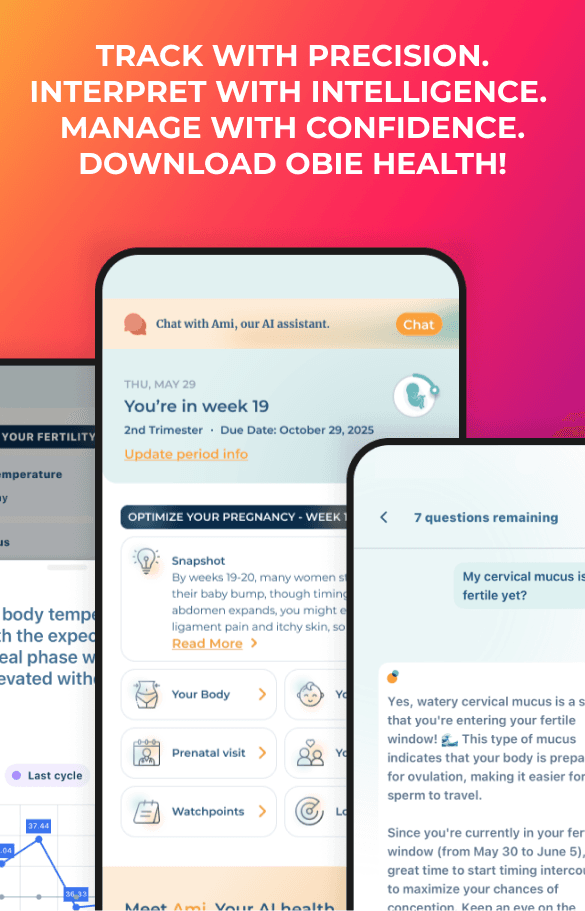Domestic Violence, Abusive Relationships, and Pregnancy
Reproductive Health
Obie Editorial Team

Domestic violence and being in an abusive relationship is more common than many other conditions for which pregnant women are routinely screened
Pregnant women and women who are trying to conceive are at increased risk of domestic violence or intimate partner violence (IVP). And being in an abusive relationship increases your risk of being exposed to domestic violence. Each year, over 300,000 pregnant women (or about 1 in 12 pregnant women) are thought to experience IVP.
Pregnant women and those trying to conceive are at increased risk of partner violence: 1.5 million women in the U.S. are thought to be affected by IVP each year. Unintended pregnancy, delayed prenatal care, alcohol, drug use, and smoking may contribute to IVP during pregnancy.
During pregnancy, there are many opportunities within the current health care system for screening and early intervention during routine prenatal care or during episodic care in a hospital setting. Up to about 50% of homicides in pregnancy are related to domestic abuse. However, most victims of domestic abuse in pregnancy are never properly screened.
- "Am I in an abusive relationship?" Questionnaire: Get screened for domestic violence here.
One in 4 women and one in 10 men experience IPV, and violence can take various forms: it can be physical, emotional, sexual, or psychological. People of all races, cultures, genders, sexual orientations, socioeconomic classes, and religions experience IPV. However, such violence has a disproportionate effect on communities of color and other marginalized groups.
What is domestic violence?
Domestic violence which is also known as intimate partner violence (IPV) is defined by The Centers for Disease Control and Prevention (CDC) as actual or threatened physical or sexual violence, or psychological and emotional abuse, directed at a spouse, former spouse, current or former boyfriend or girlfriend, or dating partner. It's not just physical abuse or threats but also emotional abuse. Abuse in any form can have negative consequences for pregnancy outcomes.
Domestic or intimate partner violence varies
There are many different ways domestic or intimate partner violence IPV expresses itself. It can range from one episode of violence that could have a lasting impact to chronic and severe episodes over multiple years.
IPV includes four types of behavior:
- Physical violence is when a person hurts or tries to hurt a partner by hitting, kicking, or using another type of physical force.
- Sexual violence is forcing or attempting to force a partner to take part in a sex act, sexual touching, or a non-physical sexual event (e.g., sexting) when the partner does not or cannot consent.
- Stalking is a pattern of repeated, unwanted attention and contact by a partner that causes fear or concern for one’s own safety or the safety of someone close to the victim.
- Psychological aggression is the use of verbal and non-verbal communication with the intent to harm another person mentally or emotionally and/or to exert control over another person.
IPV is also connected to other forms of violence and is related to serious health issues and economic consequences. You can read more about domestic or intimate partner violence here.
Take this screening test to see if you are at risk of domestic violence.
IPV and other forms of violence can be prevented.
IPV can be prevented. Read more about prevention strategies here.
How to cover your tracks online
Abusers often discover your internet activities by checking your computer as there are many clues left to what you were doing online. As a rule, internet browsers will save certain information as you surf the internet.
The safest way to find information on the internet would be at a local library, a friend’s house, or at work.
Resources for victims
- Domestic Violence Hotline or text LOVEIS to 22522, or call 1-800-799-7233
- Resources by state for domestic violence victims
- Resources and phone numbers
- Responding to domestic violence and finding a lawyer
- Leaving an abusive relationship
- Crisis Text Line (text HOME to 741741)
- National Parent Helpline (call 1-855-427-2736)
- Childhelp National Child Abuse Hotline 1-800-422-4453)
- Futures Without Violence 800-799-SAFE (7233)
- How to get out of an abusive relationship
Health effects on women
According to the Centers for Disease Control and Prevention, National Center for Injury Prevention and Control, Division of Violence Prevention, "Victims of IPV may experience numerous health-related consequences. Physical consequences range from bruises and pain to broken bones, pregnancy complications, and chronic disorders of the nervous and circulatory systems. IPV is one of the major contributors to injuries for women and long-term, adverse health-related effects persist after the violence has stopped. Effects on mental health include depression, anxiety, suicidal behavior, and post-traumatic stress disorder. Additionally, a history of IPV is associated with adverse health behaviors, such as substance abuse and risky sexual behaviors."
Study of intimate partner violence and children
Clinical psychologist and psychology professor at Michigan State University, Alytia Levendosky has seen enough domestic violence to fear the damage isn’t limited to the adults in a difficult relationship. Her latest study of domestic violence indicates its negative effects begin in the womb. Furthermore, exposure to this form of violence before birth produces psychological symptoms of trauma during a child’s first year of life.
Levendosky enlisted 182 mothers between 18 and 34 years of age for her study which analyzed the effects of these factors:
- Expectant mother’s prenatal abuse by her male partner
- Parenting style
- Maternal age, marital status, and income
- Drug or alcohol use
- Other negative life events
Domestic violence affects children
Findings indicate children who “witnessed” domestic violence from the womb experience a greater degree of behaviors indicating psychological trauma than children born under more peaceful circumstances, including:
- Nightmares
- Being easily startled
- Bothered by bright lights and loud noises
- Avoidance of physical contact
- Difficulty experiencing pleasure
In addition, the stress hormone cortisol fuels behaviors of trauma in early childhood. According to a study on the effects of domestic violence on children, “Cortisol is a neurotoxin, so it has damaging effects on the brain when elevated to excessive levels,” such as the levels of prolonged stress a physically or emotionally abused woman may feel during pregnancy. It is possible the cortisol released into the traumatized mother’s bloodstream also increases the cortisol level in the fetal blood supply.
Intimate partner violence goes unreported
Many women do not report IVP voluntarily. According to CDC data, 96% of all pregnant women seek prenatal care, making an average of 12 or 13 prenatal care visits during a pregnancy. These numbers demonstrate an ideal opportunity to screen for IVP.
Identifying intimate partner violence (IPV) in healthcare settings is becoming the standard of care. The Brief Inpatient Screen (BIS) was designed to assess recent emotional, physical, and sexual abuse in a general inpatient medical-surgical setting and compared to the Composite Abuse Scale (CAS).
In a study where researchers matched “cases” (inpatients screening BIS-positive) to up to four “controls” (inpatients screening BIS-negative.) Forty-six female hospital inpatients ages 18–64 years completed a self-administered survey. The sensitivity and specificity of the BIS and its subscales were compared to the CAS. We examined the performance of the BIS when used as a verbal screen versus an anonymously written screen.
Turn your old cellphone into a lifeline for abuse victims
Domestic violence is a form of bullying that takes many forms. The abuser likely guards the woman’s contact with outsiders. The abuser may also closely monitor the woman’s money if she’s allowed any money at all. Cellphones and other electronic communication devices provide the perfect opportunity to monitor a woman’s contact around the clock. She may want to reach out for help but is afraid of accelerated violence if the abuser finds evidence of her doing so.
A nonprofit organization called Secure The Call, based in Maryland, collects old and unwanted cell phones. It recycles phones that can no longer be used, keeping them out of landfills. Those that can still be used are wiped clean of the previous user’s personal data and converted into free 911-only phones for senior citizens and victims of domestic violence. The free phones are then distributed nationwide via police departments, women’s shelters, senior centers, and similar facilities.
As a 911-only phone, no service contract is needed. Simply keep the phone charged up so it’s usable as needed. Victims of IVP will receive instructions on how to keep the phone hidden from their abuser.
Read More









